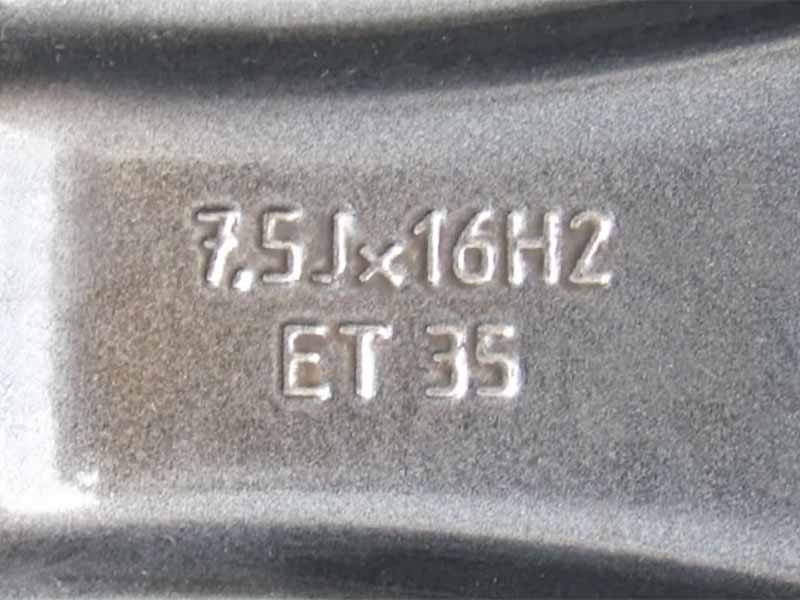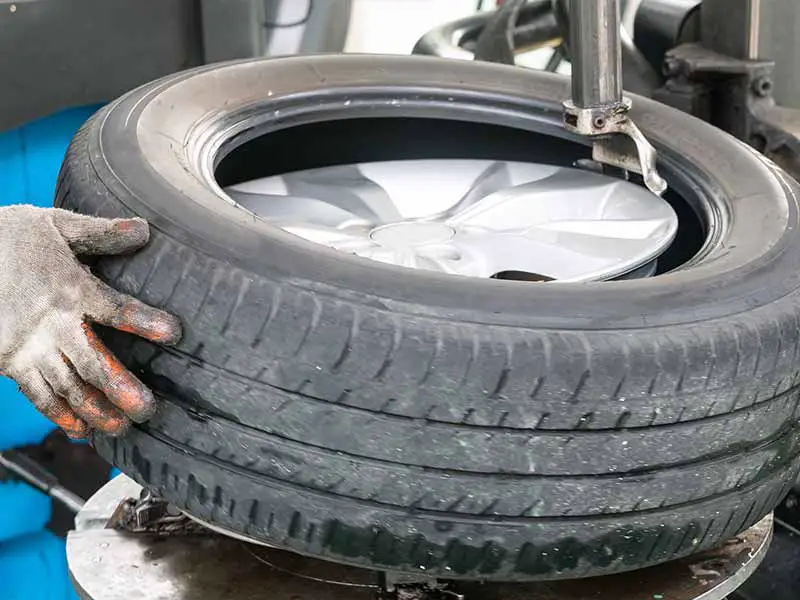The tire sidewall height (aspect ratio) of your tires can easily be changed regardless of your wheel size. The tire width (section width) can also be changed but it’s a bit more complicated.
There are side effects to consider when changing both of these tire sizes, however. Rubbing fenders and suspension components is a concern when making more significant changes. As well as the effect changing the overall tire diameter will have on the wheel speed sensors.
Can You Change Tire Size On The Same Rim?
Yes, changing tire size on the same rim is very possible as long as you ensure the tires fit the wheel width. You also need to ensure there is enough clearance inside the wheel well if you choose bigger tires that are wider, taller, or both.
If you’d like to go with wider or narrower tires you can do so and maintain a similar rolling diameter by choosing an aspect ratio that as closely as possible matches the rolling diameter of the tire you’re replacing.
Let’s take a closer look.
Rim Width Tire Size Calculator
Rim Width Tire Size Chart
| Rim Width | Min Tire Width | Recommended Tire Width | Max Tire Width |
|---|---|---|---|
| 5 Inch | 155mm | 165mm – 175mm | 185mm |
| 5.5 Inch | 165mm | 175mm – 185mm | 195mm |
| 6 Inch | 175mm | 185mm – 195mm | 205mm |
| 6.5 Inch | 185mm | 195mm – 205mm | 215mm |
| 7 Inch | 195mm | 205mm – 215mm | 225mm |
| 7.5 Inch | 205mm | 215mm – 225mm | 235mm |
| 8 Inch | 215mm | 225mm – 235mm | 245mm |
| 8.5 Inch | 225mm | 235mm – 245mm | 255mm |
| 9 Inch | 235mm | 245mm – 255mm | 265mm |
| 9.5 Inch | 245mm | 255mm – 265mm | 275mm |
| 10 Inch | 255mm | 265mm – 275mm | 285mm |
| 10.5 Inch | 265mm | 275mm – 285mm | 295mm |
| 11 Inch | 275mm | 285mm – 295mm | 305mm |
| 11.5 Inch | 285mm | 295mm – 305mm | 315mm |
| 12 Inch | 295mm | 305mm – 315mm | 325mm |
| 12.5 Inch | 305mm | 315mm – 325mm | 335mm |
| 13 Inch | 315mm | 325mm – 335mm | 345mm |
| 13.5 Inch | 325mm | 335mm – 345mm | 355mm |
| 14 Inch | 335mm | 345mm – 355mm | 365mm |
Keep in mind that this chart is a guide meant to provide an average reasonable expectation of tire widths acceptable for a given rim width. There will likely be outliers where this chart doesn’t match up.
Also, just because a given tire fits on your stock wheels doesn’t mean that you won’t experience rubbing. This is especially true for those of you with modified suspension systems. Lowered cars and trucks usually have a lot less clearance than those at stock ride height.
How To Tell What Size Rims You Have
Wheel size is generally only thought of as the diameter that you must choose for your tire to fit. Wheel diameter is measured in inches and you can count on the tire size that currently is mounted onto your wheel to be the wheel diameter. You won’t need to look any further for that measurement.
Unfortunately, diameter isn’t the only measurement you need to consider. Wheel width is also very important, but it’s a little more difficult to confirm. You can usually refer to your owner’s manual if you bought your car or truck new and know the wheels haven’t been swapped out. If you bought your car used, I recommend finding the wheel size that’s molded into the wheel to ensure you are working with the correct size.

7.5 Inches Wide, 16 Inches Diameter, Offset 35
J = Passenger Car Tire Bead Profile
H2 = Double Hump Rim Profile
This is usually on the back side of one of the spokes, but the location can vary quite a bit depending on the wheel manufacturer and the shape or design of the wheel. To make it easier to find, I recommend you remove one of the wheels to inspect the backside more easily. Don’t forget to torque your lug nuts back to the manufacturer’s spec when you put the wheel back on though.
What Do The 3 Numbers Mean On Tire Size?
Each tire has 3 main numbers molded into the sidewall that correspond with one of the 3 main measurements of your tire’s size:
- Tread Width
- Aspect Ratio
- Wheel Diameter
These 3 measurements are often referred to as the tire size. They will usually appear like the following example:
Tire Size Example: 235/45 18
The first number displayed on the tire measures the width of the tire from sidewall to sidewall. The 235 on the tire represents the section width as measured at its widest part from one sidewall to the other, in this case, 235 millimeters.
The second number on the tire, 45, represents the aspect ratio as a percentage. This means the height of the tire is 45% of the tire’s width in this example for a measurement of 105.75mm.
And the last number, in this case, 18 represents the rim diameter of the wheel which is measured in inches.
Now let’s discuss each measurement in more detail.
Tread Width
The tread width or section width is the first number displayed in the tire size sequence and is measured in millimeters. This number represents the measurement from the widest point on the inner sidewall to the outer sidewall. It doesn’t include raised lettering and protective and decorative protrusions.
Tread width is actually the measurement from the inner tread edge to the outer tread edge. The tread width isn’t listed on the sidewall of the tire.
Section width is usually slightly wider than tread width since it includes the sidewall and any slight bulge that might be part of it. These measurements are very similar and the names are often used interchangeably.
Aspect Ratio
The second number displayed on the tire sidewall is the aspect ratio. This number tells you how tall your tire’s sidewall is as a percentage of the width. To convert the percentage to an actual measurement, multiply the section width by the aspect ratio converted to a decimal:
235 * .45 = 105.75mm
A lower aspect ratio means a tire with a lower profile and a shorter sidewall, while a tire with a higher aspect ratio has a taller sidewall.
Wheel Diameter
The last of the 3 main tire size measurements is the diameter of the wheel on which the tire is mounted in inches, in our case 18. To confirm this number, you don’t measure the whole diameter of a wheel.
Wheels have what is called an “overall diameter” and an “actual diameter”. The actual diameter is the measurement used on the tire, while the overall diameter is slightly bigger since it’s measured from the outside edges of the wheel.
Can I Put Wider Tires On My Stock Rims?
Yes, you can. However, if you’re thinking about replacing your tires with a different width, you should know that modifying your vehicle’s tire size has a lot more impact on it than just aesthetics. Wider tires that may fit on a given wheel may rub against the fender, upper control arm, or strut/shock.
This may only happen when your wheels turn all the way to the right or the left. Other times it could happen only over harsh bumps that cause the springs to compress a lot more than normal. If you’re unlucky, it could happen quite frequently or actually be rubbing on the fender or another component all the time.
When done properly, choosing to use larger tire sizes can improve the performance of your vehicle. Wider tires generally improve traction but reduce mpg, while narrow tires reduce traction but improve mpg.
When changing tire width you may want to consider trying to maintain the same rolling diameter as the tire that you’re replacing to reduce the chance of problems with wheel speed sensors not reading accurately. This will keep your speedometer displaying a more accurate speed and should cause fewer problems with ABS and traction control systems.
How Much Difference In Tire Width Is Acceptable?
The general consensus is to not exceed a 3% difference when changing from the OEM size on a vehicle that hasn’t been modified. This is considered a reasonably safe amount of difference in width but isn’t terribly significant.
From our previous example size of 235/45 18, 3% is an additional 7mm or 242mm. Tires are not offered except in widths in 5mm increments so 240 would be safe but 245 would be risky and may rub.
To get a more accurate gauge for whether a set of tires fit on your car or truck without rubbing, you’ll want to measure the available clearance of the current tires. By measuring the current clearances you can check against the dimensions of the new tires and make sure there is still enough room.
Can I Use Tires With A Different Aspect Ratio?
Yes, you can change the aspect ratio (sidewall height) of your tires. Keep in mind that the rolling diameter of the new tire will be different, and therefore the speedometer accuracy may be affected.
Taller sidewalls improve ride comfort but many will want to reduce sidewall height for better looks. Whichever direction you go, keep in mind that the aspect ratio is a percentage of the section width.
Speedometer Error Calculator
How Much Difference In Tire Aspect Ratio Is Acceptable?
Increased aspect ratio results in a taller overall tire which may rub suspension components or your fenders. A 3% difference in tire size is generally considered a safe range that will not likely rub or cause significant issues with your speedometer, or electronic stability systems, or cause rubbing. Though this is no guarantee.
Tire Width Vs Height
Sidewall height is represented as a percentage of the width and is properly referred to as “aspect ratio”. This is essentially a percentage of the width. Changing tire width affects the sidewall height, which in turn affects the ride height of your car or truck very slightly.
For instance, a 235/45 18 tire and a 245/45 18 tire have different sidewall heights.
235 * .45 = 105.75mm
245 * .45 = 110.25mm
Does Rim Width Matter?
The width of the rim (properly referred to as the wheel) affects how wide a tire will fit. Every chosen wheel width has a range of tire widths that would work.
It’s important to choose tires that are within the range that will fit. Pushing the limits can lead to tires that won’t seal against the rim properly or cause the sidewall to not hold the proper shape.
Resources
Below are some links you may find helpful when learning about tires
- How to measure for installing larger wheels and tires – Chevy Hardcore
- What tires can fit my rim – United Tires
Final Thoughts
There are many reasons for wanting to change the size of your tires while keeping the existing wheels you currently have. Some will want bigger tires while others may want smaller tires. Changing tire size affects several areas such as ride quality, traction, and fuel economy.
Just know that when changing the tire size on the same rims the overall diameter of the tire should be kept as close as possible to the vehicle manufacturer’s OEM tire diameter. This will help avoid issues with traction control, ABS, your speedometer, and any other mechanical bits that depend on knowing wheel speed.
Also, bigger tires, whether wider tires or taller tires should be checked to ensure there is enough clearance in the wheel wells to accommodate the larger tires.
Good luck and happy motoring.




